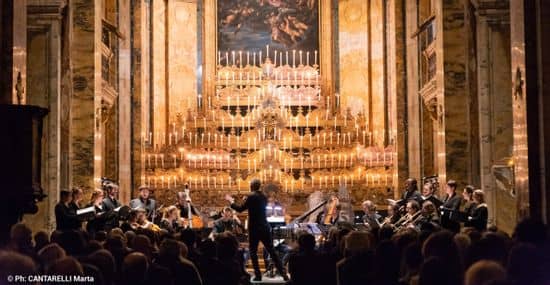The Forty Hours in Rome
At the beginning of the 16th-century, a spectacular new liturgy was born in Italy. Following in the footsteps of the Catholic inventions of the Counter-Reformation period, it featured the exposition of the Blessed Sacrament in an unprecedented temporality: for forty continuous hours, the faithful were invited to contemplate the Sacred Host, meditating on Christ’s transubstantiation to the point of dizziness. The symbolism of the number 40 also draws on a series of powerful references, from Christ’s journey in the desert to the hours spent at the tomb. For two centuries, these forty-hour services spread across Italy and France, from small Alpine churches to large Parisian parishes, as a symbolic and active bulwark against the Reformation.
This liturgy was highly effective, and quickly became an asset in the battle of religious opinions that raged at the time. The clergy did not hesitate to spice up this meditation with special prayers for the faithful wherever they found themselves : they added processions in town, but also numerous secular elements, so much so that these Quarantore were considered superstition, even by some of the Catholic clergy… Protestants, agitated by the effectiveness of these 40 hours on the devotees, demonized these ceremonies as witchcraft for heretics.
Introduced in Rome in 1550, at the rate of one service per month, they found a special setting during carnival time : the Roman clergy saw it as an ideal opportunity to combat the scattering of souls by the carnival, which flooded the city with entertainment. The office of the Forty Hours was staged on a scale we can scarcely imagine today… The liturgy uses every conceivable artifice, implemented by a regista (usually a man of letters and entertainment) : illuminated painted canvases, construction of scenery that transformed the appearance of the church, allegories, mirrors (symbolizing the vanity of the world) placed throughout the church, skeletons moving in the dark, outdoor scenery (erupting rocks, flames, fountains, raging seas…). The flamboyant centerpiece of the ceremony was a magical instrument, a kind of theatrical machine designed to explode with light : the forty-hour machine. From the small wooden console holding a few dozen candles in the smallest parish, to the large-scale installations designed by Bernini for the great Roman churches, these machines have become a myth, all the more so as most of them have been destroyed over the centuries.
What do we know about the music played there?
Sébastien Daucé began investigating three years ago, focusing his research on the Forty Hours in Rome in the mid-seventeenth century. Joined by musicologist Huub van der Linden since 2022, they have been scouring the holdings of Roman libraries, in search of the slightest clue relating directly to these services, the music that was definitely played there, and the artists who may have taken part. As with any ephemeral, non-commercial event, traces are rare and often hidden. Nevertheless, after three years of research, they discovered unheard-of music, mostly by forgotten composers, whose scores directly evoke those spectacular hours.
Concerts given in Rome for the first time on March 28 and 29, 2025 in the Saint-Louis-des-Français church, on the initiative of ROMA BAROCCA IN MUSICA.
This program is supported by the Bettencourt Schueller Foundation and the Société Générale Corporate Foundation.
This program was supported by the CNM through its international development projects program.
